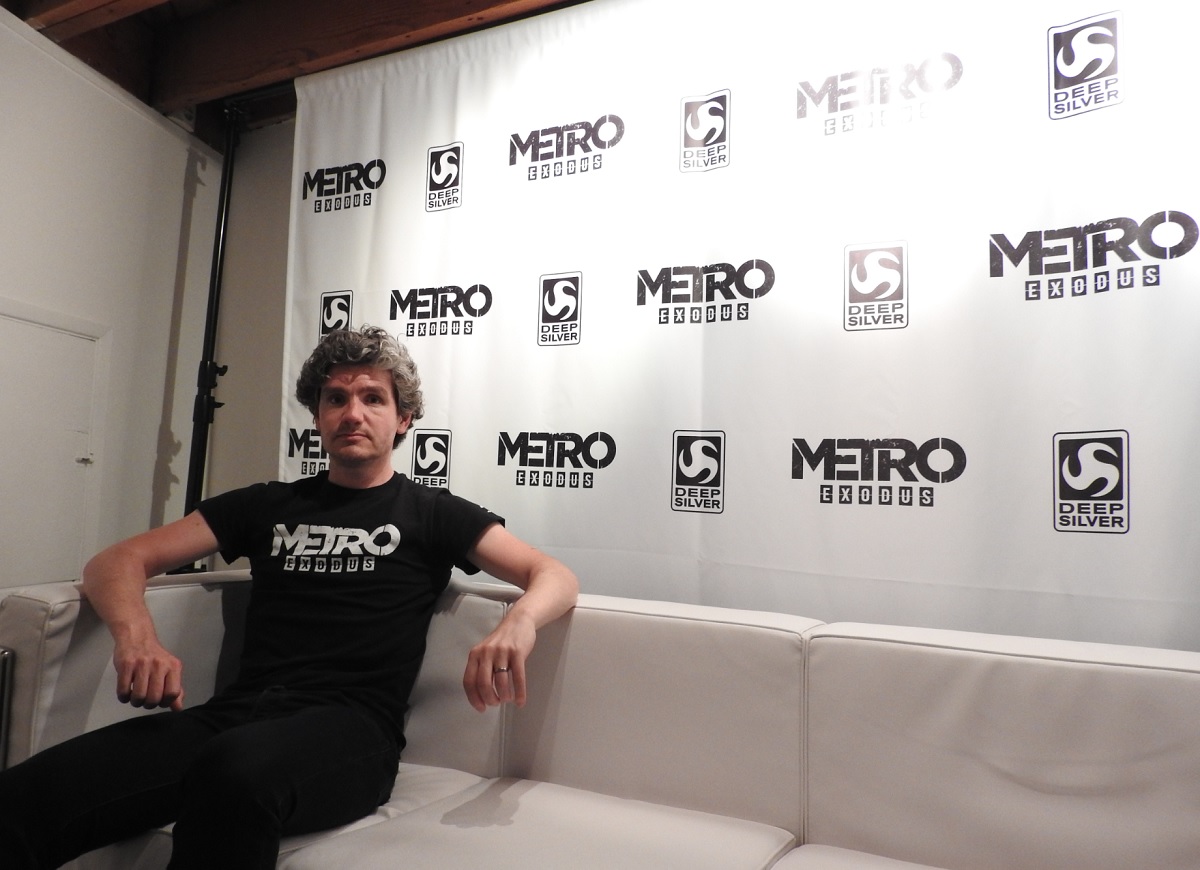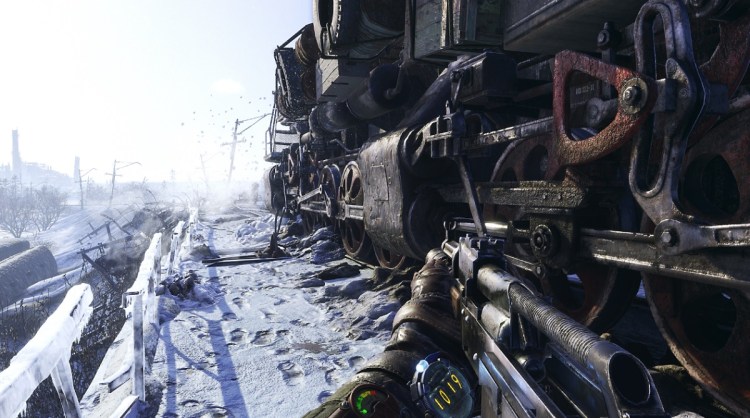Huw Beynon remembered doing a demo for me back in 2011, when Metro: Last Light debuted. And there was Deep Silver’s head of global brand management again when I recently played a demo of Metro Exodus, the third installment in the Metro game series that is coming from developer 4A Games and publisher Deep Silver in 2019 for PlayStation 4, Xbox One, and Windows PC.
The Metro series takes place in the wasteland of the Russian Federation, after a nuclear war with the U.S. in 2013. Based on the novel Metro 2033 by Dmitry Alexeevich Glukhovsky, the series is a high-end shooter experience where the goal is to survive. Mutated creatures dominate the outdoors, and humans were forced to live in underground bunkers and scavenge on the radioactive surface. But you have to deal with the demons, mutants, and tribal surviving humans as well. Metro Exodus has some snazzy graphics, and the build that I saw didn’t move fast, at something less than 30 frames per second. But it has a long way to go before launch.
The section we played had a good story about a cult and a church, and it also had a challenging mission where I had to rescue a survivor on top of a crane, so that he could lend his mechanical skills to repairing our train. I managed to run out of bullets quickly in one of my firefights, and I had to start over. Beynon said the developers “make no apologies” for the unforgiving nature of the game. It’s a harsh environment, with deadly human and demonic enemies. After all, the post-apocalyptic life isn’t going to be pretty.
Here’s an edited transcript of our interview.
June 5th: The AI Audit in NYC
Join us next week in NYC to engage with top executive leaders, delving into strategies for auditing AI models to ensure fairness, optimal performance, and ethical compliance across diverse organizations. Secure your attendance for this exclusive invite-only event.

Above: Huy Beynon of 4A Games talks about Metro Exodus.
GamesBeat: Have you been on this project the whole time?
Huw Beynon: I’ve been working on Metro a long time. In fact, I remember presenting to you back at the 2011 judges’ day when we showed Metro: Last Light. The scene on the train carriage. I think it was you who asked me if the rocking train carriage would throw off your aim, just like it did in Uncharted. Yes, it did! [laughs] I spent quite a lot of time at THQ. I did some work on STALKER with the guys who went on to move to 4A Games. I’ve been working heavily on Metro pretty much from the beginning of the series with them, but always on the publisher side, not the developer side.
GamesBeat: The gameplay we’re seeing here, is that at the beginning?
Beynon: It’s pretty early on. This is the first big, open level that you get to explore. We spent a bit of time in Moscow, and then for reasons we’re not going to go into, because we don’t want to spoil the story, you have caught a leave, and this is where you walk out.
GamesBeat: It’s not a game where you want to waste bullets.
Beynon: We make no apologies. Metro is an unforgiving game, in some ways. It demands a particular play style. You need to be stealthy. You need to conserve your resources. If you go in as a run-and-gunner, it’ll chew you up and spit you back out. You do need to adjust your strategy a little bit. It can be a challenging game. We do try to cater to a lot of different play styles, but it’s definitely a little more hardcore than some shooters.
GamesBeat: I was struck by the variety of creatures you’re running up against — water, land, all kinds.
Beynon: You’ll see a few that you might recognize from previous Metro games. Each time we’ve tried to re-imagine the mutants. With Exodus they’re even closer to the creatures you can imagine that they evolved from. Hopefully you’ll see their heritage in them. A lot of them are unique to their specific environments. You saw the aquas that live in the water around the swampy bridge level. Later in the game we’ll take you to some very different environments where you’ll find new creatures that are indigenous to each area.
GamesBeat: I was a little worried that the swimming ones were going to jump on my boat, and then they did. They don’t do it every time. But they’re pretty scary when they create that wake under your boat.
Beynon: Yeah, there’s that Jaws feeling as they go underneath, that sense of unease. The big one, he’s always out there in the water. As you explore around, sometimes you can see him just coasting along, close to the shore. If you antagonize him, he can come and have a go at you.
GamesBeat: When that creature jumped up on the boat, that was probably my favorite part.
Beynon: You might see a little bit more of him, later in the level.

Above: Stephan in front of the Aurora train in Metro Exodus.
GamesBeat: When you fall in the water you’re pretty helpless. You’re suddenly flailing around for a period.
Beynon: There’s no swimming in the game, so if you fall in the water, you’d better hope you’re close to a piece of shore. That’ll determine what you can do.
GamesBeat: I thought it was a nice touch when whatever that Jaws thing was — when he swam right by me while I was underwater. There are some great effects in there to disturb you.
Beynon: Yeah, yeah. It’s meant to be a frightening, hostile world. You shouldn’t feel safe or comfortable or secure at any point. Maybe when you’re back at the Aurora and you’ve got your Spartans around you. But every time you forge out on your next objective or next quest, we kind of want that fear of the unknown to be present all the time. You have to be thinking about what’s around the next corner, what’s in the next valley.
GamesBeat: With the fog, you’re wondering if he’s imagining this foreign occupying army.
Beynon: Well — I don’t want to say too much about the story. But there are a few little hints and teases amongst what you’ve played there now. That could be a red herring, or it could be the real plotline. I think you’ll have to wait and see before we talk more about that. What do you think?
GamesBeat: I think there’s probably no foreign occupying army that would either want this land or be able to survive in it. It seems like it might be imaginary. At least that’s what I would guess from the mood of the game?
Beynon: My face remains, for the record, inscrutable.
GamesBeat: The previous games saw a lot of fans coming up with ideas about the story. Does this game have any fan-inspired elements in it that way?
Beynon: No, I think it’s more this ongoing collaboration with Dmitry Glukhovsky. I couldn’t speak for individual elements, because I’m not in the weeds of the writing. It may well be there are little bits. I can’t say, “No, we’ve never incorporated any of that.” I’m not close enough to the writing to answer that truthfully. But most of all it’s a collaboration with Dmitry.
Our relationship with him has changed from game to game. With the first one, he’d already written the story. It was about how we adapted that existing source material to become a game. With Last Light it was more about looking for a plotline before he’d really written the novel, which we then evolved into a video game storyline. This time around, the idea, the concept of the journey, came from the studio first, and then that inspired Dmitry and triggered some more process in him. It interwove with the novel that went on to become Metro 2035. The games and books kind of interweave amongst each other.

Above: This demon won’t last too long in Metro Exodus.
GamesBeat: It seems like you found more creative control, or creative freedom on these later games.
Beynon: Dmitry has always been very democratic about his work. I don’t know if you were aware, but he’s allowed a lot of writers to create Metro novels in different countries all around the world, loosely based within the Metro universe. He’s a very creative individual. He just likes helping and facilitating these projects.
GamesBeat: It feels like it’s in an earlier stage of development still. What could we expect as far as the speed of the gameplay? Are you targeting something that plays fairly fast at 4K? Or is 30 frames per second a more realistic target?
Beynon: It’s not something that’s been 100 percent decided. We hit 60 frames per second for Metro Redux, but that was much smaller, more linear gameplay. We do a huge amount of simulation in Exodus. We have much larger environments, lots of AI simulation, the day-night cycle going on. We’ll do what we can, but I’d say wait and have a look at the final code before we put a number on it.
GamesBeat: What were some of the technical advances you wanted to deliver, to make this different from the previous games?
Beynon: The technology is always in service to the story that we’re trying to tell. One of the big changes, obviously, is this new move to more open environments, the idea that you’re going to spend a lot of time in these environments. Although Metro has always been known for its very strong lighting, particularly in interiors, when we’ve had that more linear gameplay we’ve always controlled that experience for the player. This level is going to be in the daytime. This level is going to be at night. We’ll light this interior artfully or moodily depending on the situation.
We’ve moved to this more — what we describe as miniature open worlds, where you might spend several days of in-game time. We had to develop a completely new system whereby everything looks natural, realistic, at any time of day, both exteriors and interiors. That was a pretty significant undertaking. We’re also taking the player to many more different types of environments. What you saw was Moscow in the springtime, so still quite bleak, quite post-apocalyptic in feel. But that’s just a taste of some of the things to come. I think people will be quite surprised by some of the environments we take them to in Exodus. Again, these all offer very different art styles, palettes, textures, and so on.
GamesBeat: You can never quite tell whether the humans or the creatures are the most dangerous thing out there.
Beynon: Yeah, I think that’s been an underlying message from Dmitry’s novels, from the start, to be honest.


